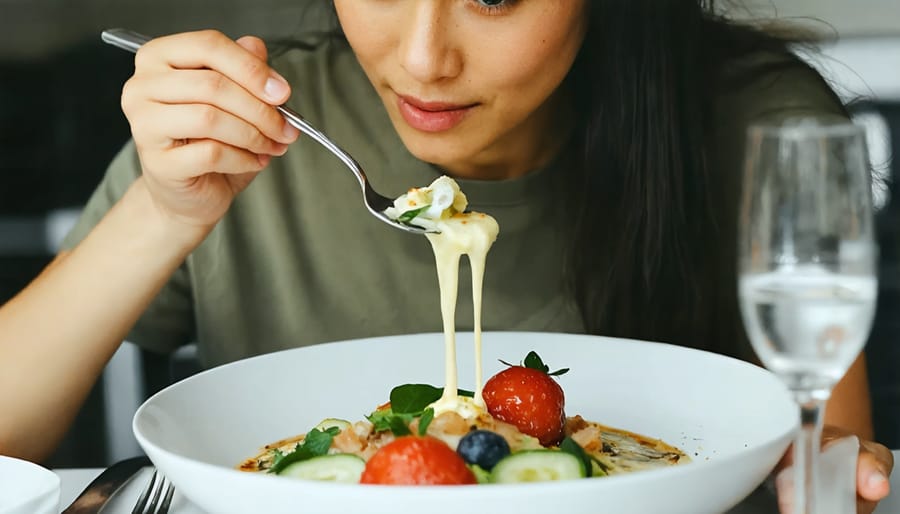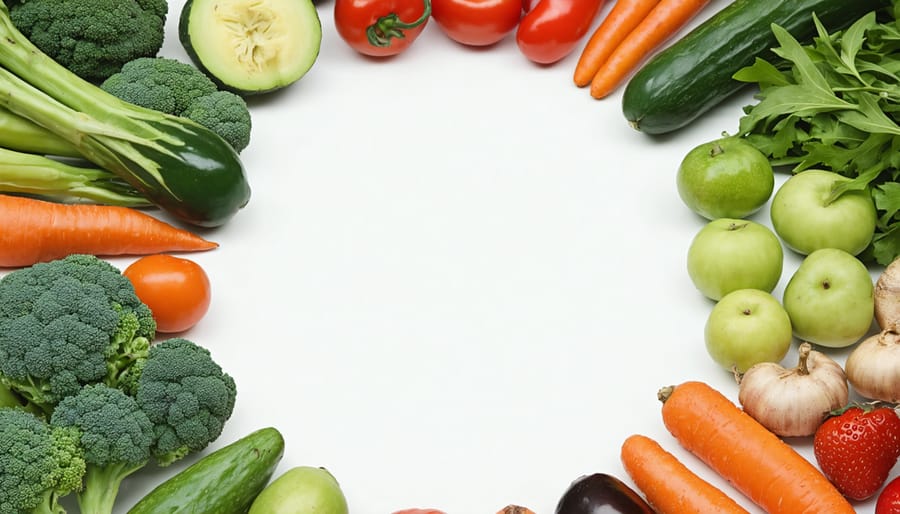
Picture yourself at your kitchen table, fork poised mid-air, caught between your usual mealtime habits and a nagging feeling that there must be a better way to approach eating. You’re not alone. As our relationship with food becomes increasingly complex, two powerful approaches have emerged as beacons of hope for those seeking a more balanced relationship with eating: mindful eating and intuitive eating.
While these terms often get used interchangeably, they represent distinct philosophies that can transform your relationship with food. Mindful eating focuses on the present-moment experience of consuming food—the textures, flavors, and sensations—while intuitive eating embraces a broader approach that honors your body’s natural hunger and fullness cues while rejecting diet culture altogether.
As someone who’s journeyed from counting every calorie to finding peace with food, I’ve discovered that understanding these approaches isn’t just about changing how we eat—it’s about revolutionizing our entire relationship with nourishment. Whether you’re tired of emotional eating patterns or simply seeking a more peaceful approach to meals, exploring these complementary practices could be your first step toward food freedom.
Let’s dive into the nuances of these approaches and discover which might better serve your journey toward a healthier relationship with food.
The Art of Mindful Eating
What Makes Eating Mindful?
Picture yourself savoring each bite of your favorite meal, noticing the textures, flavors, and aromas as they dance across your palate. That’s the essence of mindful eating – a practice that transforms our relationship with food from a mindless activity into a rich, sensory experience. Research consistently shows that mindful eating actually works by helping us develop a deeper connection with our food choices and eating habits.
At its core, mindful eating involves bringing your full attention to the present moment during meals. This means turning off the TV, putting away your phone, and truly focusing on your food. It’s about observing your thoughts and feelings about food without judgment, while staying aware of your body’s hunger and fullness signals.
Key elements of mindful eating include:
– Eating slowly and without distraction
– Paying attention to the colors, smells, textures, and flavors of your food
– Noticing how food makes you feel before, during, and after eating
– Recognizing emotional triggers that might influence your eating habits
– Making conscious food choices that honor both your health and your taste preferences
Think of mindful eating as bringing meditation to your meals. Just as meditation helps calm your mind, mindful eating helps you develop a more peaceful and aware relationship with food. It’s not about strict rules or perfect behavior – it’s about being present and making conscious choices that serve your well-being.

Practical Mindful Eating Techniques
Let’s dive into some practical techniques that can transform your relationship with food through mindfulness. As someone who initially struggled with distracted eating, I’ve found these mindful practices to be game-changers in my own journey.
Start by creating a peaceful eating environment – turn off the TV, put away your phone, and find a quiet space to enjoy your meal. Before taking your first bite, take three deep breaths and observe your food’s colors, textures, and aromas. This simple ritual helps transition your mind from busy mode to eating mode.
Try the “first bite” exercise: take your initial bite with complete awareness, noticing the temperature, texture, and flavors as they unfold. Chew slowly and deliberately, aiming for 20-30 chews per bite. This might feel strange at first, but it becomes natural with practice.
Use your non-dominant hand occasionally to slow down your eating pace, or try eating with chopsticks for a different experience. Set your utensils down between bites – this simple act creates natural pauses for checking in with your hunger and fullness levels.
Remember, mindful eating isn’t about perfection. Start with one meal a day, perhaps breakfast when you’re less rushed, and gradually expand these practices to other meals as they become more comfortable.
Understanding Intuitive Eating

The Core Principles
When exploring these nourishing approaches to eating, it’s essential to understand their foundational principles. Intuitive eating embraces ten core principles that guide us toward a healthier relationship with food. At its heart is the rejection of diet culture and the trust in our body’s natural wisdom.
The first principle encourages us to ditch the diet mentality completely. This means letting go of quick-fix solutions and embracing a more sustainable approach to nourishment. Another crucial principle is honoring your hunger – learning to respond to your body’s early signals rather than waiting until you’re ravenously hungry.
Developing body awareness plays a vital role in both practices. This includes recognizing feelings of fullness, satisfaction, and the emotional aspects of eating. The principles also emphasize making peace with food, challenging the “food police,” and discovering the satisfaction factor in eating.
Perhaps most importantly, these approaches encourage gentle nutrition without strict rules. They remind us that health isn’t just about what we eat – it’s about nurturing a positive relationship with food and our bodies. These principles work together to create a framework that supports both physical and emotional well-being, helping us move away from restrictive eating patterns toward a more balanced, joy-filled approach to nourishment.
Breaking Free from Diet Culture
Remember that moment when you first realized how much mental space dieting occupied in your life? For many of us, breaking free from diet culture feels like finally taking a deep breath after holding it for years. Intuitive eating offers a refreshing alternative to the exhausting cycle of restrictive diets and food rules.
Instead of following external guidelines about what, when, and how much to eat, intuitive eating encourages us to trust our body’s wisdom. Think about young children – they naturally eat when hungry and stop when full, without counting calories or feeling guilty about enjoying dessert.
Diet culture has convinced many of us that we can’t trust ourselves around food, that we need strict rules to maintain our health. But intuitive eating challenges these beliefs by promoting a peaceful relationship with food and our bodies. It’s about letting go of the “good food/bad food” mentality and embracing all foods without judgment.
Making this shift isn’t always easy. After years of dieting, learning to trust your body’s signals takes time and patience. But imagine the freedom of enjoying a meal without calculating its nutritional value or feeling guilty afterward. That’s the promise of intuitive eating – a return to a more natural, peaceful way of nourishing ourselves.
The journey might feel uncomfortable at first, but remember: your body has been waiting for this homecoming.

Mindful vs. Intuitive: Key Differences
While both mindful and intuitive eating promote a healthier relationship with food, they each bring unique elements to the table. Think of mindful eating as being fully present during your meals – like savoring each bite of your morning toast and really noticing its texture, warmth, and flavor. It’s about engaging all your senses and bringing your full attention to the eating experience.
Intuitive eating, on the other hand, is more like having a friendly conversation with your body. It’s learning to trust your natural hunger and fullness cues, and giving yourself unconditional permission to eat what truly satisfies you. Remember those times when you just knew exactly what your body needed? That’s intuitive eating in action!
Here’s where they differ: Mindful eating focuses on the ‘how’ of eating – slowing down, avoiding distractions, and being present in the moment. It’s particularly helpful for those of us who tend to eat while scrolling through our phones or working at our desks. Intuitive eating, meanwhile, emphasizes the ‘why’ – helping you understand your emotional connections to food and challenging those rigid diet rules many of us have internalized.
I remember when I first started practicing both approaches. Mindful eating helped me slow down and actually taste my food instead of rushing through meals, while intuitive eating helped me break free from the guilt I used to feel about eating certain foods. They work beautifully together, but you might find that one resonates more with you initially.
The beauty is that these approaches aren’t mutually exclusive – they can complement each other perfectly. Mindful eating can enhance your ability to listen to your body’s signals, while intuitive eating can help you respond to those signals with self-compassion and wisdom. Together, they create a powerful framework for developing a peaceful, balanced relationship with food.
Finding Your Perfect Balance
Finding harmony between mindful and intuitive eating doesn’t mean choosing one over the other – it’s about creating a personalized approach that works for you. Think of it like crafting your own wellness recipe, where you can balance your body and mind by taking the most beneficial elements from both practices.
I remember when I first started combining these approaches. Some days, I’d practice mindful eating by savoring my morning coffee, while other times, I’d trust my intuitive cues about when and what to eat. What I discovered was that these practices actually complement each other beautifully.
Here’s how you can blend both approaches:
Start by incorporating mindful moments into your meals – perhaps taking three deep breaths before eating or spending the first few bites really focusing on the flavors and textures. Then, let your intuitive wisdom guide you about portion sizes and when to stop eating.
Listen to your body’s hunger and fullness signals while staying present in the moment. If you’re craving something specific, honor that craving but eat it mindfully. This combination helps you enjoy your food more while maintaining a healthy relationship with eating.
Remember that some days will feel more intuitive, while others might benefit from more mindful practices. That’s perfectly okay! The key is flexibility and self-compassion. Pay attention to what works best for you in different situations – maybe mindful eating helps during stressful workdays, while intuitive eating feels more natural on weekends.
Start small by choosing one meal a day to practice this combined approach. Notice how it feels, and gradually extend these practices to other meals as you become more comfortable. The goal isn’t perfection but rather finding a sustainable way to nourish yourself that feels authentic and enjoyable.
As we wrap up our exploration of mindful and intuitive eating, remember that there’s no one-size-fits-all approach to developing a healthy relationship with food. Both practices offer valuable insights and tools that can work together to help you create a more balanced, enjoyable eating experience.
Think of these approaches as different paths leading to the same destination – a more peaceful relationship with food and your body. While mindful eating helps you stay present and engaged during meals, intuitive eating encourages you to trust your body’s natural wisdom. You might find that one resonates more strongly with you, or perhaps a combination of both practices feels right.
I’ve seen many women in our community transform their relationship with food by starting small – maybe just taking three mindful breaths before meals or checking in with their hunger levels throughout the day. Remember, this is a journey, not a race. Be patient with yourself as you explore these practices.
I encourage you to experiment with both approaches in the coming weeks. Notice how different meals feel when you practice mindfulness, and observe what happens when you trust your body’s intuitive signals. Share your experiences with friends or join our community discussions – sometimes the best insights come from hearing others’ stories.
The most important thing is to approach this journey with curiosity and self-compassion. Your relationship with food is unique, and it’s okay to take time discovering what works best for you.



